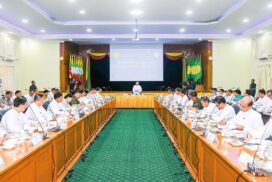Rice is the staple food of Myanmar with those with high affordability consuming Pawsan species of rice while those with low income rely upon a bit rough or coarse-grained species. In the domestic market, Pawsan is the most famous among the rich. Nonetheless, in the 1970s, Pawsan was not that famous, and the Ngakywe species was of the highest quality consumed by the prosperous and the people of the medium class. However, Ngakywe was also known as Meedon, which is now called Pawkywe. The term Meedon was used by the state-owned purchase depots.
Rice Production in the past
During the pre-war period, Myanmar was one of the major exporters of rice around the world. There were a lot of rice mills owned privately in addition to the state-owned ones. The private brands were also famous in the world market with some topping the exporters’ list. In the post-independence period, private entrepreneurs were granted to be engaged in the trading of paddy and rice. The Delta Area witnessed huge rice mills and big paddy/rice go-downs.
Beyond 1962, when rice and paddy trading was nationalized, private entrepreneurs could not be engaged in this business. Nevertheless, the rice mills were not nationalized. Therefore, the paddy can be milled by private entrepreneurs, and for almost three decades, the privately-owned rice mills were assigned the duty to mill the paddy for both governments’ prescribed quota and self-sufficiency paddy for the farmers. The government exported the surplus paddy only. Nonetheless, the volume of trade was rather low when compared to that exported before 1962.
Varieties of Rice
In the aftermath of the 1962 coup launched by General Ne Win, the farmland was owned by the state, and the farmers, therefore, were required to sell at least 12 baskets of paddy per acre per annum to the government’s purchase depots. The surplus paddy, which is the difference between the prescribed quota and the yield per acre, can be milled for the self-sufficiency of the farmers. The consumers could buy the quota rice from the Public Property Corporation Shops [later from the co-operative society shops]. Some bought the rice direct from the farmers in addition to the quota rice. In those days, both fine-grained and coarse-grained rice was consumed by the people without much discrimination between the former and the latter.
Among the paddy species procured by the state-owned purchase depots, Nga Kywe was sold for the highest price. The colour of the paddy was black. The paddy species — Ngakywe, Meedon, Ngasein, Hnanka, Emahta and Kaukhnyin — were bought by the state-owned paddy purchase depots at the prescribed prices depending on the species. One basket of paddy weighs 46 pounds.
Market Economy and Rice Production
In the post-1988 period, when the market-oriented economy was first introduced, private entrepreneurs were permitted to be engaged in rice/paddy trading businesses. With the new economic policy concerning rice/paddy laid down, rice export grew, resulting in the ability to export more than three million tons of rice and rice products in 2020. This volume of export was equal to the annual export tonnage before the pre-war period.
Famous Pawsan – Hybrid of Ngakywe and Meedon
In addition to the export of coarse-grained rice, the local rice market had become rather competitive again. Between 1988 and 2022, there had emerged a new species of both coarse-grained and fine-grained rice. Around the 1980s, there arose a new species known as Pawsan, a hybrid of Ngakywe and Meedon. During the period when the farmers had to sell the prescribed quota of paddy to the government, there had also arisen another species called Ngakywe Taungpyan, which was of the highest quality. This species produced long-grained rice when cooked. This rice was soft and delicate. In addition to Ngakywe Taungpyan, there had also emerged Kaukkyi Taungpyan. Afterwards, there had also arisen sub-species of Pawsan known as Pawsan Shwewah, Pawsan Baygya and Pawsan Taungpyan. These Pawsan species sold well in the market. However, the Taungpyan species produced less rice when milled.
In the post-1970s, the rice species produced in Pathein were quite famous in the market, selling the first. The consumers liked these Pathein species because they produced a higher volume of rice compared to other species.
Depending upon the water type, soil type and paddy prices, the quality of rice varies from species to species. The Ngakywe Hmwe, Kaukkyi and Taungpyan produced in the Delta Area sold very well in the market. Nonetheless, this popularity has faded gradually for a lack of properly maintaining the quality, for not cultivating at the right time and for not using the pedigree seeds.
Out of the paddy-cultivating towns in the Delta Area, only nine townships had Pawsan species cultivated. When Ngakywe Hmwe lost its popularity, Pathein Pawsan, Myaungmya Pawsan and Pyapon Pawsan became the best sellers in the post-2000s period.
Shwebo Pawsan
In 2007, Shwebo Pawsan started to be famous among the people living in Pakokku Region. These days, this species topped the list of the best sellers. This is sold for the highest price. Around 2005, the Pawsan species from the Delta Area was moved to the Shwebo Region for cultivation on an experimental basis. Stinking less fragrance, the quality of this species is excellent, producing long-grained rice, which does not decompose in the intense heat. Regarding the per-acre yield, Shwebo Pawsan yields better, 70 baskets per acre when compared to Delta species, which yields only 40/50 baskets per acre.
It is learnt that there are 354,785 acres of land in Shwebo which are put under cultivation of Pawsan species. There is a great dam in Shwebo which supplies the irrigated water for cultivation. Shwebo Pawsan species are being sold throughout the country but Yangon is its biggest market. It is also learnt that around three-lakh bags of rice are being transported every month to Wahdan rice market in Yangon.
Prices of Pawsan Rice
The rice brokerages usually demonstrate the quality of their rice by cooking it in front of potential buyers. The same species of rice usually have sub-categories, which are sold for different prices. There are at last three sub-categories for a rice species. Most consumers prefer to have a look at the sample rice cooked in their presence. But their choice is also influenced by the prices. The highest-priced Shwebo Pawsan ranges from K82,000 to K91,000 per bag. Contrary to the name Shwebo Pawsan, there is also the same species produced not in Shwebo but in the Delta Area. This rice species are being sold for around K75,000 per bag. Pathein/Myaungmya Pawsan species are being sold wholesale for K70,000 per bag while Pyapon Pawsan, Bogale Mawgyun Pawsan and Dedaye Kyapyan Pawsan are being sold for K68,000, K65,000 and K70,000 per bag respectively, according to certain rice brokerages in the Bayintnaung depot. Thanks to modern rice mills using advanced milling technology, the rice has become higher grade.
Yangon – the Biggest Market for Pawsan Species
The Pawsan rice is being chiefly sold by the wholesale traders in Yangon Commodity Depot and Bayintnaung brokerages with less volume of rice being sold in other towns. Yangon, which has a population of seven million, has the biggest market for Pawsan species. Those who can afford to buy in advance summer rice, cooking oil, onion and chilli etc., for fear of shortage of supply. This being so, they do not suffer from the price hike. Pawsan consumers are also in the habit of panic buying.
As for the home delivery businessmen, they have the rice cleansed and have the rice bags delivered right up to the doorstep. In addition to the rice bags of one-and-a-half baskets, they are also selling the smaller size of rice bags — a half basket or a quarter basket. The delivery costs the buyer only K5,000 or so per basket.
The retailers inside the wards are selling the rice per pyi for K3,000 to K4,000. The coarse-grained rice consumed by the majority of people is sold for K2,000 or so per pyi while the wholesale price is fixed between K35,000 per bag and K44,000 per bag. Therefore, the price of Pawsan doubles that of coarse-grained species.
Price Changing Trends
Before 1964, the daily wage was K3.15. With the passage of 55 years, the daily wage is K4,800 now. In 2020, the coarse-grained species was sold for around K20,000 per bag while the broken rice was sold for K17,000 per bag and Pawsan, for about K50,000 per bag respectively. In mid-2020 however, the coarse-grained species were sold for bout K30,000 per bag whereas the broken rice, for around K30,000 per bag and Pawsan, for about K70,000 per bag respectively. So, this year witnessed peak prices.
Changing Trends in Consumption of Rice
True to the consumers’ behaviour, people have turned to alternative choices. Instead of consuming Pawsan, some middle-income earners have turned to cheaper-priced rice known as the Delta Pawsan, which is sold for K20,000 or so per bag. Ordinary Pawsan’s price has risen up to about K30,000 above that of the coarse-grained rice species. The people have, therefore, become thrifty, mixing the coarse-grained and the fine-grained rice species.
Current Market Before the Monsoon Paddy Yield
The price hike of rice can be attributed to the higher price of paddy. Before the Monsoon paddy yield, the price of coarse-grained paddy is about K1.2 million per 100 baskets while that of Delta Pawsan is around K1.6 million and that of Shwebo Pawsan is about K2.0 million per 100 baskets respectively.
As the rice can be stored for only a few months, the rice merchants are required to dispose of the go-downs before the yield of the new rice. Naturally, the traders would tend to create higher demand for their old rice, manipulating the prices of rice. The coarse-grained rice is consumed only domestically, and so, the supply is sufficient till the yield of new rice. Only 25 per cent of Emahta rice and the broken rice are exported. Pawsan is not exported. Therefore, people ought not to panic buying, which will only aggravate the rice market.
The Rice NGO is selling the rice to the consumers. Under their arrangement, three species of fine-grained rice and one species of coarse-grained rice are being distributed commencing from August and will continue to be sold up to October. This arrangement is believed to mitigate the concern of the consumers. During this three-month period, Monsoon coarse-grained paddy will yield. Likewise, the old-age paddy of the new Pawsan will also be produced.
Sagaing Region is home to paddy-cultivating farmers, and so, the rice produced from this region is transported to the whole country, chiefly to Yangon. Such being the case, the prices of rice are very unlikely to rise to a record high. Nonetheless, the traders who have stored the rice will manipulate the rice prices. Therefore, people are advised not to panic buying.
Translated.














